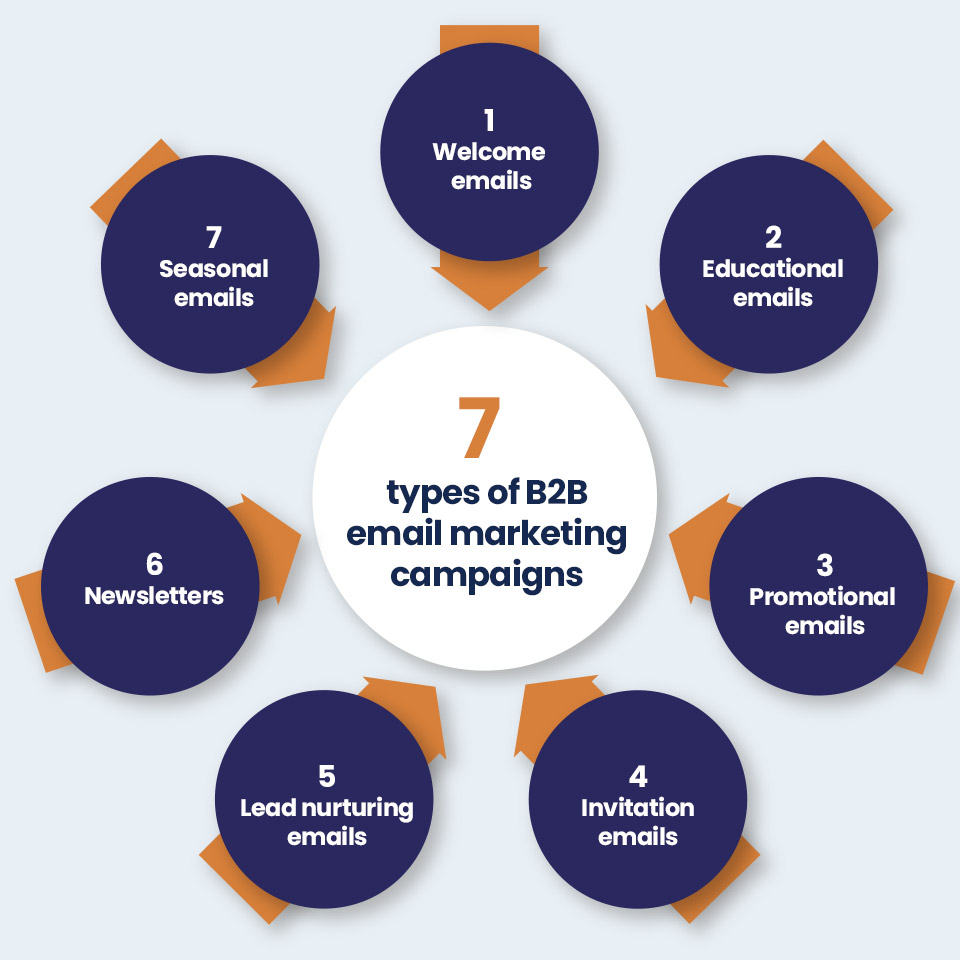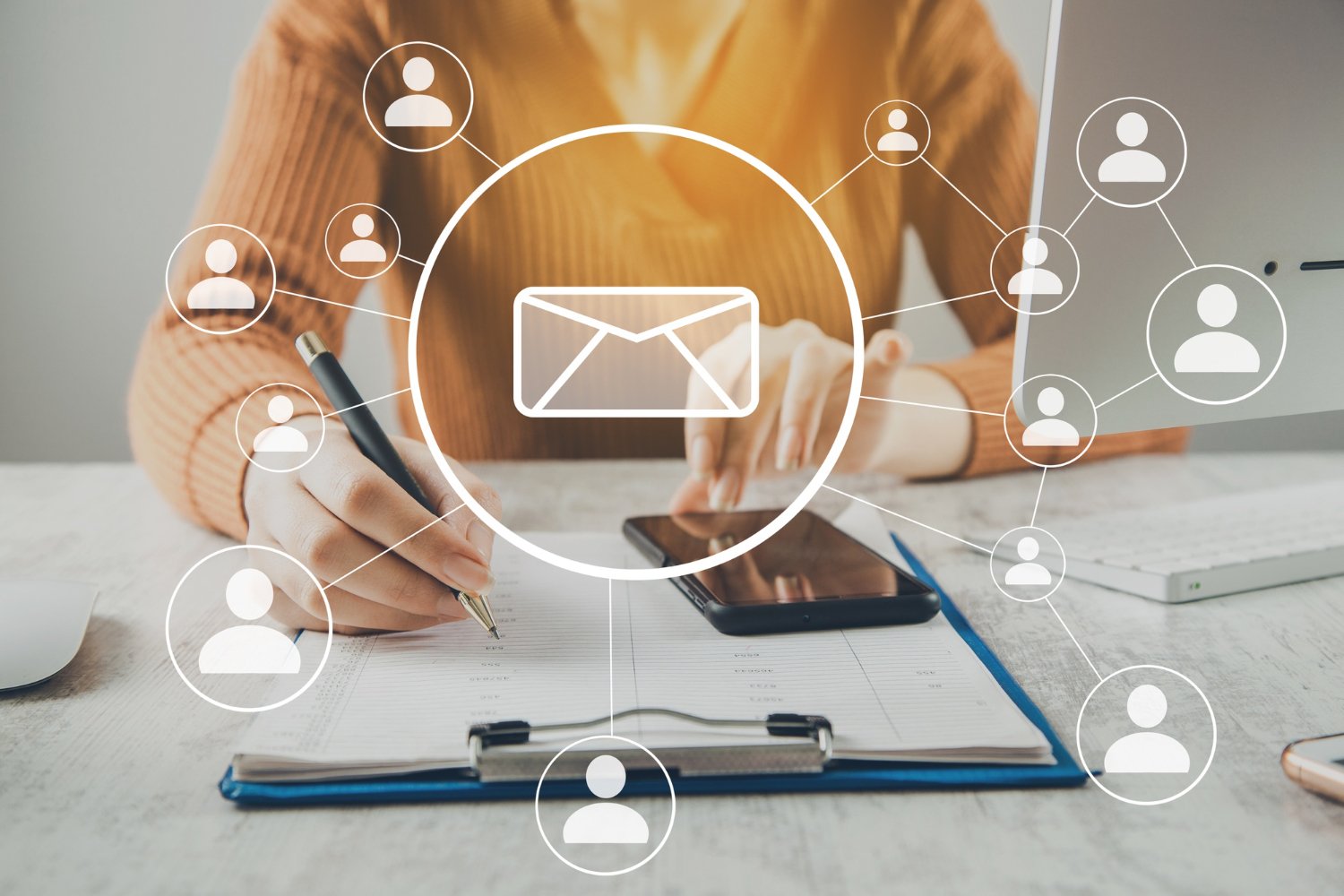Email marketing is a powerful tool for businesses. Different email campaigns serve different purposes.
Understanding these types can boost your marketing efforts. Email campaigns are diverse and cater to various business needs. Some emails are meant to welcome new subscribers. Others aim to nurture leads or re-engage inactive customers. Each type has its unique strategy and goal.
Knowing which campaign to use can enhance your connection with your audience. It also helps in achieving specific business objectives. In this blog post, we will explore the different types of email campaigns. You’ll learn how each one can benefit your marketing strategy. Let’s dive in and discover the best email campaigns for your needs.

Credit: www.b2bresolute.com
Welcome Emails
Welcome emails are the first interaction with your new subscribers. They set the tone for future communications and build initial trust. Effective welcome emails can significantly impact engagement and retention.
First Impressions
First impressions matter. A well-crafted welcome email can leave a lasting impact. Start with a friendly greeting and thank the subscriber for joining. Use a warm and inviting tone to make them feel valued.
Personalize the email by using their name. This small touch can make a big difference. Highlight the benefits of being on your email list. Let them know what to expect from your emails.
Setting Expectations
Clear expectations help build trust. Inform your subscribers about the type of content they will receive. Mention how often you will email them. This helps to avoid surprises and sets a clear communication pattern.
Provide a brief overview of your brand or service. This helps new subscribers understand your values and mission. Include links to your social media profiles. Encourage them to connect with you on other platforms.
End with a strong call to action. Invite them to explore your website or check out your latest products. A clear and engaging welcome email sets a positive tone for future interactions.
Newsletter Emails
Newsletter emails keep your audience informed. They provide regular updates and engaging content. By sending newsletters, you build a connection with your subscribers.
Regular Updates
Consistent updates help keep your audience engaged. Share company news, product updates, or industry trends. This keeps your audience in the loop.
Regular updates build trust with your subscribers. They know they can rely on you for the latest information.
Engaging Content
Make sure your newsletter content is engaging. Mix different types of content to keep it interesting.
- Articles: Share blog posts or news articles.
- Videos: Include tutorial or product videos.
- Images: Use infographics or photos.
Engaging content encourages your audience to read your emails. They will look forward to your next update.
Promotional Emails
Promotional emails are a powerful tool for engaging customers and driving sales. These emails highlight special deals, discounts, or exclusive offers to encourage purchases. Businesses use them to keep customers informed and excited about new opportunities.
Sales And Discounts
Sales and discounts are the heart of promotional emails. They notify customers about price reductions on popular items. These emails create a sense of urgency. Limited-time offers often result in quick decisions from recipients. This tactic boosts sales and clears inventory efficiently.
Clear and compelling subject lines increase open rates. Examples include “50% Off Today Only!” or “Exclusive Sale Just for You.” Inside the email, a strong call to action (CTA) directs customers to the website. Adding visuals of discounted products can enhance the message.
Special Offers
Special offers provide customers with unique deals that aren’t available to everyone. These might include early access to sales, buy-one-get-one-free deals, or holiday specials. These emails make recipients feel valued and appreciated.
Personalization plays a big role here. Using the customer’s name and past purchase history can make the offer more appealing. For instance, “John, enjoy 20% off your next purchase!” This approach strengthens customer loyalty and increases the likelihood of a purchase.
Special offers can also include exclusive content, such as free e-books or early product launches. This not only drives sales but also enhances the customer experience.
Seasonal Campaigns
Seasonal campaigns are a great way to connect with your audience. These campaigns are timely and relevant. They tap into the spirit of the season. This makes them effective for driving engagement and sales.
Holiday Themes
Holiday-themed emails can create excitement. They resonate with your audience’s festive mood. Think about Christmas, Halloween, or Valentine’s Day. Use colors and images that match the holiday. Simple changes like these can make your emails stand out. Add a touch of holiday cheer to your subject lines. This can increase open rates and engagement.
Seasonal Promotions
Seasonal promotions offer special deals at the right time. Winter sales, summer discounts, or back-to-school offers are good examples. These promotions create urgency. They encourage your audience to take action. Highlight the limited-time nature of these deals. This can increase the sense of urgency and boost sales.
Transactional Emails
Transactional emails are essential for any business. They provide crucial information about transactions. These emails keep customers informed about their orders and account activities.
Order Confirmations
Order confirmation emails reassure customers about their purchases. They provide details like item names, prices, and order numbers. These emails also confirm payment receipt. This helps in building trust and reducing customer anxiety. Customers appreciate knowing their orders are being processed.
Shipping Updates
Shipping update emails keep customers informed about their shipment status. They include tracking numbers and expected delivery dates. These updates reduce customer inquiries about order status. They also enhance the overall customer experience. Timely updates help in managing customer expectations.
Credit: help.activecampaign.com
Re-engagement Emails
Re-engagement emails are essential for reconnecting with inactive subscribers. These emails help revive interest and bring users back to your brand. They often include special offers, personalized content, or reminders of the benefits they once enjoyed. Effective re-engagement emails can turn dormant subscribers into active, loyal customers again.
Win-back Strategies
Win-back strategies aim to re-attract inactive subscribers. These emails should grab attention quickly. Start with a catchy subject line. Offer a limited-time discount or exclusive deal. Remind them of what they are missing. Highlight new features or products they may like. Personalize the content to make it relevant. Use their name and previous interactions. Keep the email short and to the point.
Customer Loyalty
Customer loyalty is crucial for long-term success. Re-engagement emails can boost loyalty. Show appreciation for their past support. Send personalized thank-you notes. Offer loyalty rewards or points. Share exclusive content or early access to new products. Make them feel valued and special. Engage them with interactive content like quizzes or surveys. Listen to their feedback and act on it.
Event Invitation Emails
Event Invitation Emails play a critical role in engaging your audience and driving attendance. These emails inform recipients about upcoming events, creating excitement and encouraging registration. There are different types of event invitation emails, including those for webinars, workshops, and exclusive events. Below, we will explore each type and how they can benefit your campaign.
Webinars And Workshops
Webinars and workshops are excellent for sharing knowledge and engaging with your audience. Webinar invitation emails should clearly state the date, time, and topic. They should also highlight the benefits of attending. Use bullet points to list key takeaways:
- Expert insights
- Interactive Q&A sessions
- Exclusive resources
In contrast, workshop invitation emails should emphasize hands-on learning opportunities. Make sure to include:
- Workshop goals
- Materials provided
- Location details
Using a table can also help in presenting the details more clearly:
| Event Type | Date | Time | Location |
|---|---|---|---|
| Webinar | October 15, 2023 | 10:00 AM | Online |
| Workshop | November 5, 2023 | 2:00 PM | New York, NY |
Exclusive Events
Exclusive event invitation emails should create a sense of urgency and exclusivity. Mention limited spots and special guests. Use compelling language to make recipients feel special. These events could include:
- VIP meetups
- Product launches
- Private dinners
Highlighting unique aspects of the event can boost excitement. For example, if a celebrity will be present, mention it in bold. You can also use an ordered list to guide recipients through the registration process:
- Click on the registration link.
- Fill out the registration form.
- Check your email for confirmation.
Exclusive events should feel personal and special. Tailor your language to make the recipient feel valued and important.

Credit: www.alore.io
Survey And Feedback Emails
Survey and feedback emails are essential in gathering insights from customers. These emails help businesses understand their audience better. By asking for feedback, companies can make informed decisions and improve their services. Let’s explore how these emails contribute to customer satisfaction and product improvement.
Customer Satisfaction
Customer satisfaction is crucial for any business. A satisfied customer is more likely to return and recommend your services. Survey emails play a significant role in measuring satisfaction levels. Here’s how:
- Ask specific questions about their recent experience.
- Use rating scales to gauge their satisfaction.
- Include open-ended questions for detailed feedback.
These methods provide a clear picture of what works and what needs improvement. A simple question like, “How satisfied were you with our service?” can yield valuable insights. Always thank customers for their feedback to show appreciation.
Product Improvement
Feedback emails are vital for product improvement. They help identify product strengths and weaknesses. Consider these strategies:
- Identify common issues reported by multiple customers.
- Gather suggestions for new features or enhancements.
- Track feedback trends over time for continuous improvement.
For instance, if many customers suggest a new feature, it’s worth considering. Implementing customer suggestions can lead to better products and higher satisfaction. Feedback loops are essential for ongoing product development.
Use the feedback data to prioritize improvements. Create a table to track feedback and actions taken:
| Feedback | Action | Status |
|---|---|---|
| Feature request: Dark mode | Development started | In Progress |
| Issue: Slow loading times | Server upgrade | Completed |
This approach ensures feedback is not only collected but also acted upon. Engaging with customers through survey and feedback emails builds trust and loyalty. It shows you value their opinions and are committed to improving their experience.
Frequently Asked Questions
What Are The Main Types Of Email Campaigns?
The main types of email campaigns include welcome emails, promotional emails, newsletters, transactional emails, and re-engagement emails.
How Do Welcome Emails Work?
Welcome emails introduce new subscribers to your brand. They set expectations and provide essential information about your products or services.
What Is A Promotional Email?
A promotional email highlights a special offer, discount, or new product. Its goal is to drive sales and engagement.
Why Are Newsletters Important?
Newsletters keep your audience updated with company news, blog posts, and industry trends. They help maintain regular communication with subscribers.
Conclusion
Email campaigns offer diverse strategies for businesses. Each type serves a unique purpose. Newsletters keep your audience informed. Promotional emails drive sales. Welcome emails create a great first impression. Abandoned cart emails recover lost sales. Survey emails gather valuable feedback.
Seasonal emails engage during special times of the year. Choose the right type for your goals. Tailor your message to your audience. Effective email campaigns build strong customer relationships. Start planning your next campaign today. Happy emailing!
